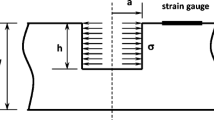Abstract
The applicability of the semidestructive holedrilling technique to the experimental determination of residual stresses in relatively thin rectangularly orthotropic materials was investigated. From the exploratory work, it was determined that the similitudes, for measurements at a particular ratio of hole depth to diameter, which exist for thick materials are not present in relatively thin materials. This implies that calibration tests must be made for each combination of strain-gage size and plate thickness.
As a consolation, however, it was found that there is no need to drill to an optimum depth for thin materials. That is, one may simply drill a small hole completely through the material to obtain the desired strain change.
Similar content being viewed by others
Abbreviations
- A, B :
-
calibration constants
- E :
-
Young's modulus
- G :
-
shear modulus associated with direction 1,2
- k :
-
general constant
- α:
-
general angle measured from the major material-symmetry axis
- ∈:
-
strain
- ∈(α):
-
strain change at some angle α
- v :
-
Poisson's ratio
- a, b, c :
-
rosette elements at 0, 45 and 90 deg
- 11, 22:
-
normal stress, normal strain or elastic constants associated with directions 1, 2
- 12:
-
shear stress or shear strain in direction 2 acting on face normal to direction 1
- 1, 2:
-
major and minor material-symmetry directions
- 1,…, 5:
-
designations for different general constants,k
References
Sachs, G., “Der Nachweiss innerer Spannungen in Stangen und Rohren,”Z. Metallk.,19,352, (1927).
Treuting, R. G. andRead, W. T., Jr., “A Mechanical Determination of Biaxial Residual Stress in Sheet Materials,”Jnl. Appl. Phys.,22,130 (1951).
Mathar, J., “Determination of Initial Stresses by Measuring the Deformations Around Drilled Holes,”Trans. ASME,56,249 (1934).
Kelsey, R. A., “Measuring Non-Uniform Residual Stresses by the Hole Drilling Method,”Proc. SESA, XIV (1),181 (1956).
Rendler, N. J. andVigness, I., “Hole-drilling Strain-gage Method of Measuring Residual Stresses,”Experimental Mechanics,6 (12),577 (1966).
Bert, C. W. andThompson, G. L., “A Method for Measuring Planar Residual Stresses in Rectangularly Orthotropic Materials,”Jnl. Compos. Mater.,2, (4),244 (1968).
Lekhnitskii, S. G., Theory of Elasticity of an Anisotropic Elastic Body, Holden-Day, San Francisco, Calif., (1963).
Author information
Authors and Affiliations
Rights and permissions
About this article
Cite this article
Lake, B.R., Appl, F.J. & Bert, C.W. An investigation of the hole-drilling technique for measuring planar residual stress in rectangularly orthotropic materials. Experimental Mechanics 10, 233–239 (1970). https://doi.org/10.1007/BF02324095
Issue Date:
DOI: https://doi.org/10.1007/BF02324095




